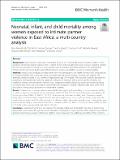Neonatal, Infant, and Child Mortality among Women Exposed to Intimate Partner Violence in East Africa: A Multi-country Analysis
View/
Publication Date
2020-01-23Type
Article, Journalviews
downloads
Metadata
Show full item recordCitation
Memiah, P., Bond, T., Opanga, Y. et al. Neonatal, infant, and child mortality among women exposed to intimate partner violence in East Africa: a multi-country analysis. BMC Women's Health 20, 10 (2020). https://doi.org/10.1186/s12905-019-0867-2
Abstract/
Background Most neonatal, infant, and child deaths occur in low- and middle-income countries (LMICs), where incidence of intimate partner violence (IPV) is highest in the world. Despite these facts, research regarding whether the two are associated is limited. The main objective was to examine associations between IPV amongst East African women and risk of death among their neonates, infants, and children, as well as related variables. Methods Analysis was conducted on data drawn from the Demographic and Health Surveys (DHS) conducted by ICF Macro/MEASURE DHS in five East African countries: Burundi, Kenya, Rwanda, Tanzania, and Uganda. The analytical sample included 11,512 women of reproductive age (15–49 years). The outcome variables, described by proportions and frequencies, were the presence or absence of neonatal, infant, and under-five mortality. Our variable of interest, intimate partner violence, was a composite variable of physical, sexual, and emotional abuse; chi-square tests were used to analyze its relationship with categorical variables. Adjusted odds ratios (aOR) were also used in linking sexual autonomy to independent variables. Results Children born to women who experienced IPV were significantly more likely to die as newborns (aOR = 1.3, 95% confidence interval [CI]: 1.4–2.2) and infants (aOR = 1.9, 95% CI: 1.6–2.2), and they were more likely to die by the age of five (aOR = 1.5, 95% CI: 1.01–1.55). Socioeconomic indicators including area of residence, wealth index, age of mother/husband, religion, level of education, employment status, and mass media usage were also significantly associated with IPV. After regression modelling, mothers who were currently using contraceptives were determined less likely to have their children die as newborns (aOR = 0.5, 95% CI: 0.3–0-7), as infants (aOR = 0.5, 95% CI: 0.3–06), and by age five (aOR = 0.4, 95% CI: 02–0.6). Conclusion Understanding IPV as a risk indicator for neonatal, infant, and child deaths can help in determining appropriate interventions. IPV against women should be considered an urgent priority within programs and policies aimed at maximizing survival of infants and children in East Africa and the wellbeing and safety of their mothers.
Further Details
© The Author(s). 2020 Open Access This article is distributed under the terms of the Creative Commons Attribution 4.0 International License (http://creativecommons.org/licenses/by/4.0/), which permits unrestricted use, distribution, and reproduction in any medium, provided you give appropriate credit to the original author(s) and the source, provide a link to the Creative Commons license, and indicate if changes were made. The Creative Commons Public Domain Dedication waiver (http://creativecommons.org/publicdomain/zero/1.0/) applies to the data made available in this article, unless otherwise stated.
Publisher
BMC Women's HealthCollections
- General - GEN [367]

